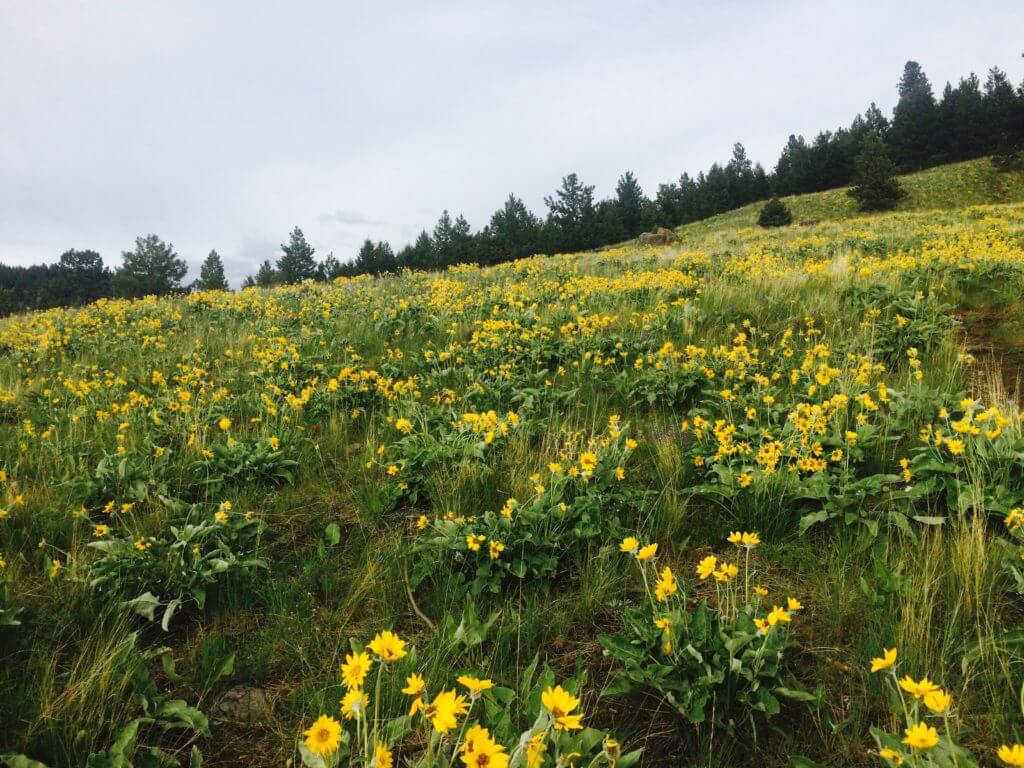Bumblebee Queens
by Sara Mintz
Broadcast 5.21 and 5.26.2017

Listen:
Recently, I was walking on Mount Jumbo, an open, dry, grassy slope, admiring the arrowleaf balsamroot flowers. It was grey shading to dreary, but the yellow flowers were cheerful and sunny, brightening the drab day.
As I was looking at the flowers, I noticed a bumblebee buzzing around me. I assumed that its attention would also be on the flowers, which even I could tell were offering pollen and inviting a visit. However, the bee was more interested in the ground. It few around and past several open flowers to land on small patches of bare dirt and tiny humps of dried grass. It never lingered anywhere long – it would stop for a moment, then fly to another spot, land for a few seconds, then fly on, until it flew away in the direction opposite to where I was going. I headed home with my head full of questions about what the bumblebee had been doing and why. Why would it ignore food in favor of bare and uninviting ground?

Arrowleaf balsamroot covers the Mount Jumbo saddle. CREDIT: ALLISON DE JONG
The first thing I learned was that the bee was a queen. Mated queen bumblebees hibernate for the winter in sheltered locations protected from both the harsh cold of winter and from unseasonable thaws that could bring them out of hibernation too early. When she finally does emerge, the young queen is focused on finding a nest site so that she can start laying her eggs. Bumblebees nest underground, in mouse or vole burrows, and the choice of a good nest location is vital to the success of the colony she’s forming. The most important criterion is that there be flowers nearby, but warmth during the volatile weather of spring is also important for the development of her eggs and larvae. Nests in poor locations don’t produce queens for next year; some even fail to survive the summer.
Once she finds a good nest site, the young queen will make a wax honeypot, so she can store food for rainy days, then lay a clutch of eggs. She’ll brood them much like a bird does, sitting on them to keep them at an evenly warm temperature, leaving the nest only on brief trips to gather food. About a month after the eggs are laid, the first of the queen’s daughters will emerge as adult workers and take over the foraging duties from their mother, who will then primarily remain in the nest, laying eggs and guarding the colony throughout the summer.
A week or so after that first sighting, I was walking in the same spot and saw another bumblebee buzzing from flower to flower. It may or may not have been the same individual, but it appears that at least one bumblebee queen has made her nest among the balsamroots. In a few weeks, I hope I’ll be seeing her daughters at work gathering food and pollinating flowers along that trail.
Every week since 1991, Field Notes has inquired about Montana’s natural history. Field Notes are written by naturalists, students, and listeners about the puzzle-tree bark, eagle talons, woolly aphids, and giant puffballs of Western, Central and Southwestern Montana and aired weekly on Montana Public Radio.
Click here to read and listen to more Field Notes. Field Notes is available as a podcast! Subscribe on iTunes, Google Play, or wherever you listen to podcasts.
Interested in writing a Field Note? Contact Allison De Jong, Field Notes editor, at adejong [at] montananaturalist [dot] org or 406.327.0405.
Want to learn more about our programs as well as fun natural history facts and seasonal phenology? Sign up for our e-newsletter! You can also become a member and get discounts on our programs as well as free reciprocal admission to 300+ science centers in North America!












